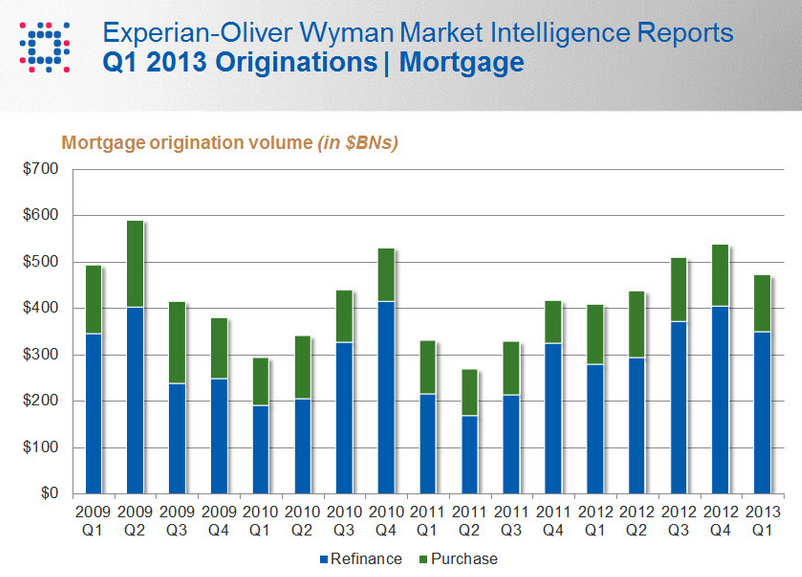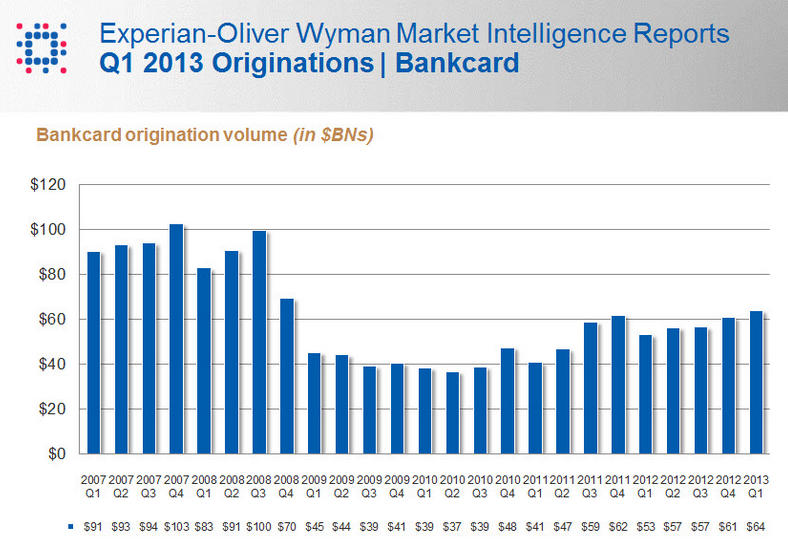Further evidence of economic recovery throughout the nation, an Experian trends analysis of new mortgages and bankcards from Q1 2013 showed a 16 percent year-over-year increase in mortgage origination volume and a 20 percent increase in bankcard limits. Other insights offered by Experian, include evidence of a strong rebound in the Midwest as well as unprecedented lows in bankcard delinquencies.
Mortgage trends
Mortgage origination volume saw a 16 percent increase over the same quarter a year ago. This upward trend in volumes over the past eight quarters points to a consistently improving housing market.

Average home prices increased slightly from 2011. California continues to lead the way, with an average home price of $325,000. The South Central region increased to $169,000, surpassing the Midwest, which came in at $163,000. However, regional share of originated mortgage dollars showed strong activity in the Midwest as the new year began, with the Midwest rebounding by growing 27 percent year over year to $101 billion.
For the first time in two years, the region surpassed California, which grew by 6 percent to $92 billion. Mortgage delinquency rates also continued to improve, reaching multiyear lows. There was a slight increase in late-stage 90- to 180-day delinquency that may be the result of continued stress in some specific housing markets.
Bankcard trends
Bankcard lending continues to slowly build every quarter, reaching a 20 percent year-over-year increase in total origination volume limits extended into the market during Q1 2013, which is up about $11 billion.

According to the analysis Experian is seeing increased bankcard lending taking place in the prime and super-prime space. Significant year-over-year growth rates occurred within the near-prime segment, which saw a 42 percent increase, while the prime space grew 30 percent.
Bankcard performance is also near record lows for each of the delinquency periods. Experian saw a slight seasonal uptick in charge-offs from 3.9 percent to 4.3 percent, but other than that, it was another very strong quarter for payment performance. The 30 to 59 days past due (DPD) went to 0.94 percent — six basis points lower than the previous quarter. Also, the 60 to 89 DPD went to 0.59 percent from 0.65 percent, and the 90 to 180 DPD was flat at 1.56 percent.
In looking at the 30-plus-day delinquency rate by state for the quarter, Experian saw North Dakota lead the best-performing states, with the lowest rate of 1.94 percent. This was followed by Alaska at 2.23 percent, Wyoming at 2.34 percent, South Dakota at 2.41 percent and Iowa at 2.42 percent.
The states that did not perform well for the quarter were Nevada at 3.81 percent, Arizona at 3.79 percent, Florida at 3.71 percent, Mississippi at 3.51 percent and Alabama at 3.40 percent. This information shows that the spread between the highest- and lowest-performing states for bankcards is continuing to close.
The data for this insight and analysis was provided by Experian’s IntelliViewSM product. IntelliView data is sourced from the information that supports the Experian–Oliver Wyman Market Intelligence Reports and is easily accessed through an intuitive, online graphical user interface, which enables financial professionals to extract key findings from the data and integrate them into their business strategies. This unique data asset does this by delivering market intelligence on consumer credit behavior within specific lending categories and geographic regions.